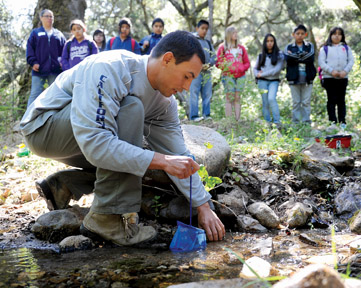
State employees at Hollister Hills host day camp for local sixth-graders
Sixth-grade students from R.O. Hardin School didn’t visit Hollister Hills to ride motorcycles as many visitors to the park do – these kids spent two days at the park for a daytime science camp program.
More than 100 students gathered May 17 and 18 at Hollister Hills State Vehicular Recreation Area south of the city.
Richard Munoz, a state park interpreter, said the staff members have hosted day trips for younger students, but this is the first time they have held a multi-day trip.
“The focus or theme of the science camp is students acting as stewards and land managers,” Munoz said. “They will do the things we do on a daily basis to balance recreation and the resource.”
The students gathered in the nature area of the park, a place where motorized vehicles are not allowed, to engage in four different sessions on the first day. The kids were divided into groups and they rotated through the stations. Two staff members led each group of students, along with chaperones, through an activity.
Munoz and Julio Ortiz taught the students about native and non-native plants.
“We are the alien invasion group,” Ortiz said. “But this is not about space. We are going to identify non-native plants, which are plants that have been brought from other places.”
The students were divided into groups of four. They were given a pamphlet with pictures of native and non-native species, a GPS unit to record their location along the trail, and a clipboard with a piece of paper to record their findings. The students were invited to walk down a trail that had spots marked by a blue flag. At each spot, they were asked to identify the nearby plants.
Munoz explained that the GPS unit marks the location of non-native species, and he said the employees at the park use control methods to keep the plants from getting out of control. He said the non-native plants will take over the native plants and they can be bad for the ecosystem. He explained that for some of the plants, they mow them down before seeds sprout. With others they use grazing animals such as cows to control them, and with some others they use herbicides to kill the plants.
As a group of girls gathered around one blue flag, they quickly identified the non-native plant.
“It’s Italian thistle,” one of the girls said, of a tall, bristly plant with a purple flower on the end.
At another station, the students learned about the Native Americans who used to live on the land.
Instructor Kathy Ohannesian taught the students about the Amah Mutsun tribe before they tried their hand at creating and painting with natural pigments.
“It’s really neat and it’s in their own backyard,” Ohannesian, said of the Hollister Hills location.
The students created natural dyes using charcoal, berries and chalk. They then had a chance to paint a picture with the dyes.
Before they had a chance to paint, Ohannesian talked to them about the ways the natives used dyes.
She showed the students the types of materials they used, such as berries, clay, charcoal and other natural substances. She explained that the natives used the pigments to paint on cave walls and on their own skin. She said the different colors and patterns used helped to identify their lineage.
“They liked red a lot, but how do you think they got it when there are no rocks of that color here?”
A couple students ventured a guess.
“They traded with others in the Almaden area,” Ohannesian said.
She also taught the kids about the three things needed to make paint – pigment, a binder and water.
The students broke into two groups, with one group working on creating more materials for the pigments and the others painting. Ohannesian mixed in some tempera paint into the paint bowls for the second group because the first group had used up a lot of the materials. The students still had a chance to identify the materials in the paint. They used natural materials as brushes, such as feathers, twigs and soap root.
“Twigs make great dots,” she said.
Another station in the day’s rotation included a lesson on water quality and hydrology that required a 10-minute hike out to a spot where the students could access water in the mostly dry Hollister Hills area. The other group engaged in a habitat hike, after which they had a chance to draw a picture of the ecosystem along the trail.
Munoz said the R.O. Hardin students would return the next day for additional activities, with sixth-graders from Cerra Vista visiting in a few weeks.
The idea of the day science camps came up when a volunteer teacher at R.O. Hardin said that her class couldn’t afford an overnight science camp, Munoz said.
“They talked with us and set up a meeting with the principal and teachers,” Munoz said. “We worked within the limitations to fit each other’s needs.”
The only cost to the schools is transportation to Hollister Hills, Munoz said, since the state park has a budget for outreach and education. He said his staff is looking into a way the students can camp overnight in future years, though he said he didn’t know when.
“It’s something we want to work toward,” he said.









